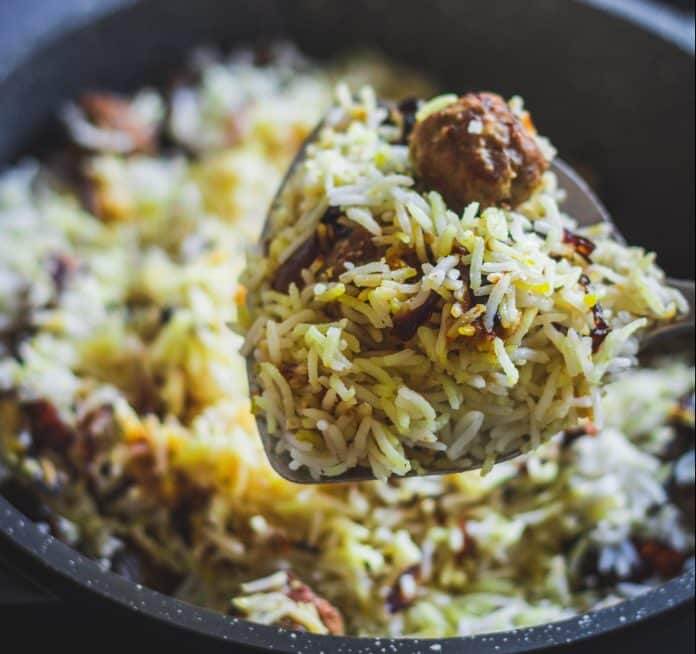A pulao is often considered to be second grade in comparison to a biryani. The general attitude is that you make a pulao when you don’t want to indulge in the extravagance of a biryani. This could not be further from the truth: here’s an Awadhi style pulao to prove this.
Awadhi cuisine from the Lucknow region is not just famous but one that’s held in reverence. The food that came out of the Awadh kitchens had a royal elegance, and continues to this day to be held in esteem for its techniques, attention to ingredients and complexity of flavours.

The cuisine is known for its ‘nafaasat’ i.e. refinement. Spices are used brilliantly to draw out the flavour of the main ingredient – be it rice, meat, fish or vegetables – and slow cooking is the preferred method to create that final harmonious medley that makes it all so refined.
Culinary literature is important when it comes to regional cuisines like this and one of my favourite cookbooks on this subject is Dastarkhwan-e-Awadh. The authors Dr Sangeeta Bhatnagar and R.K.Saxena, both culinary historians, spoke to Nawabs, chefs and cooks of the erstwhile royal households, as part of their research.
Coming to today’s dish, let it be stated at the very outset that making a good pulao requires as much skill as a biryani. The flavours are much less complex in a pulao: there are far fewer spices and aromatics and it is a subtle play of those few spices that make a pulao so delicious. It all starts with cooking the rice perfectly. Use aged long grain rice which must be fragrant and aromatic, and cook it so that each grain is separate from the other yet done perfectly.
A kofta pulao is, literally, meatballs and rice. The meatballs are shaped small in this recipe, unlike the larger ones that we are accustomed to eating in pasta or as snacks. Though mutton would be used traditionally, I have used lamb mince here, which is flavoured with just cinnamon and cardamom.
Another important ingredient is ghee or clarified butter. In traditional Awadhi cooking, tempered ghee is used but here I stick to plain ghee to keep things simple. Oil can be used but would hardly provide any flavour, and ghee is way healthier anyway.
The rice and koftas are cooked separately and then layered; the cooking process is then finished using the dum technique. For those who aren’t aware, this is where all the ingredients are placed inside one pot and the edges sealed using dough. Slow charcoal heat is applied on top and bottom, and the food is allowed to slow cook with minimal heat.
Now most of us would use a modern dum technique in our homes. You could either place all the ingredients in a casserole dish, seal using a foil and finish cooking at low heat in the oven. Or you could follow my technique: since I don’t like to use foil, I cover with a tea towel and then place the lid on top so that it’s really tight and no steam escapes. The pot is then placed on a flat tawa or directly on heat but at its lowest setting. Ensure that the edges of the towel hanging out is scrunched up; we don’t want to start a fire!
Kofta Pulao
500gms aged basmati (long grained) rice; washed and soaked for at least 1 hour
500gms lamb (or mutton) mince
1 inch piece ginger
5 medium garlic cloves
1 tsp red chilli powder
10gms roasted gram flour
1 inch cinnamon stick
3 whole green cardamom
Salt, to season
Ghee (clarified butter)
5 medium red onions
1 ½ tbsp rose water
1 pinch saffron
250 ml milk
Grind the cinnamon and cardamom to a fine powder.
Grind the garlic and ginger to a paste (add a few drops of water if necessary)
Also grind 2 onions to a coarse paste and keep aside.
Finely slice the remaining 3 onions; fry in ghee till golden brown, drain and keep aside.
Into the mince, add half of the cinnamon-cardamom powder, roasted gram flour, 1 tbsp ghee and salt to season. Knead well to ensure that all the ingredients are mixed well and the mince has a fine consistency.
Take small portions of the mince and roll into small balls (slightly larger than marbles). You will roughly get about 30 -35 balls. Heat ghee in a pan and fry the meatballs; keep aside. (Take care not to overcook or the meatballs taste dry)
To cook the rice, heat 1 ½ litres water. Season with salt and add the remaining cardamom-cinnamon powder. Add the washed rice and parboil; drain and keep aside.
In the same pan that the onions were fried (add more ghee only if necessary), add the onion and ginger garlic paste. Sauté on medium heat till the rawness disappears. Then add chilli powder and sauté till the ghee separates.
Add the fried meatballs to this and add 1 cup (250 ml) water. Cook till most of the water has disappeared. Taste and season with salt if necessary.
Meanwhile soak saffron in warm milk.
To finally assemble the dish, place a large deep bottom vessel on low heat and add half of the cooked rice. Then layer with the cooked koftas/meatballs, add half of the rose water and saffron milk. Then add the remaining rice followed by the remaining rose water and saffron milk.
Seal the edges (read description above for dum techniques) of the vessel and cook covered on low heat for about 20 minutes.
Open just before serving and garnish with fried onions.
Serve with a raita.





